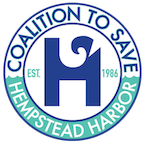Winter Kelp Monitoring
For the first time this past winter, The Town of Oyster Bay grew sugar kelp in three marinas; Tappen Beach, Theodore Roosevelt and TOBAY, as part of a bio-extraction initiative to remove pollutants from our waters. Coalition to Save Hempstead Harbor, in turn, incorporated a winter monitoring program to test the positive impact of growing kelp, primarily nitrogen reduction in the water. CSHH collected water samples biweekly and samples were processed at labs. The data is presently still under review.
What is kelp?
Sugar kelp is a type of seaweed, which grows in the winter months and is harvested in spring. This growth season complements that of seed clams, which are grown in the summer and removed in fall, and have been for the past two seasons at Tappen Marina. The sugar kelp, which is seen below being pulled from the water, will be dried and used as fertilizer on town golf courses.
Why is this important?
Too much nitrogen in the water, as a result of runoff from excess fertilizers or failing cesspools and septic systems, results in the accelerated growth of algae, called “blooms.” These blooms can block light from entering the water column and can adversely affect marine organisms. As the algal cells die, they use up the oxygen that is needed for marine life to thrive. High density of algal cells can result in fish kills, and some types can be toxic to humans and pets.
What can we do?
Never fertilize before a forecasted rainstorm
Switch to natural organic fertilizers and use them sparingly
Don't leave yard waste in the street or allow it to fall into storm drains
Compost your yard waste and use it in your gardens and planters



